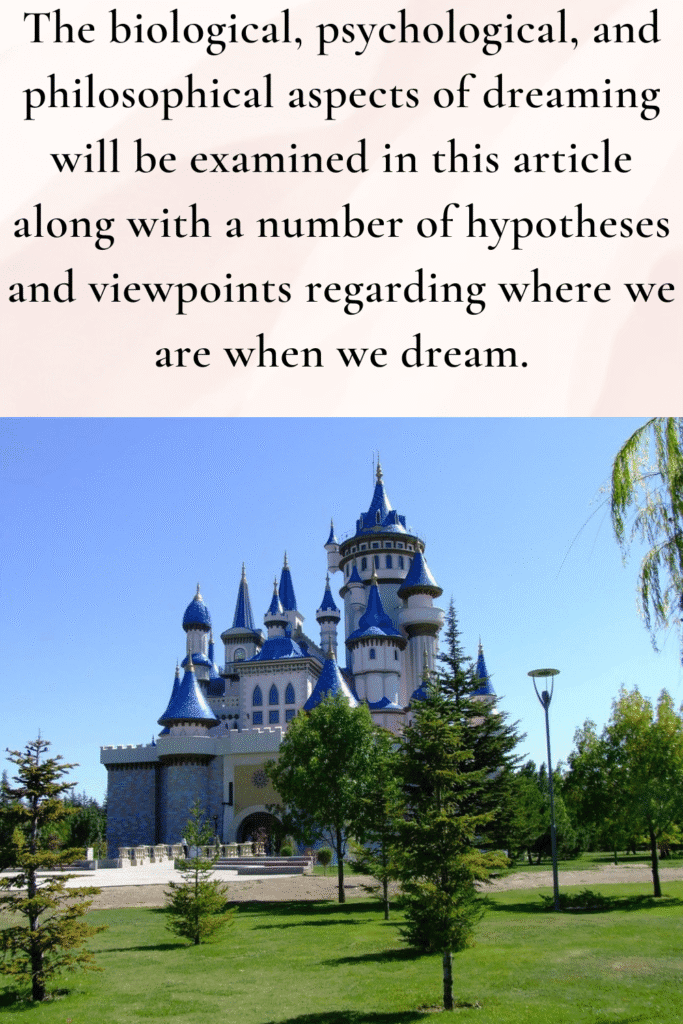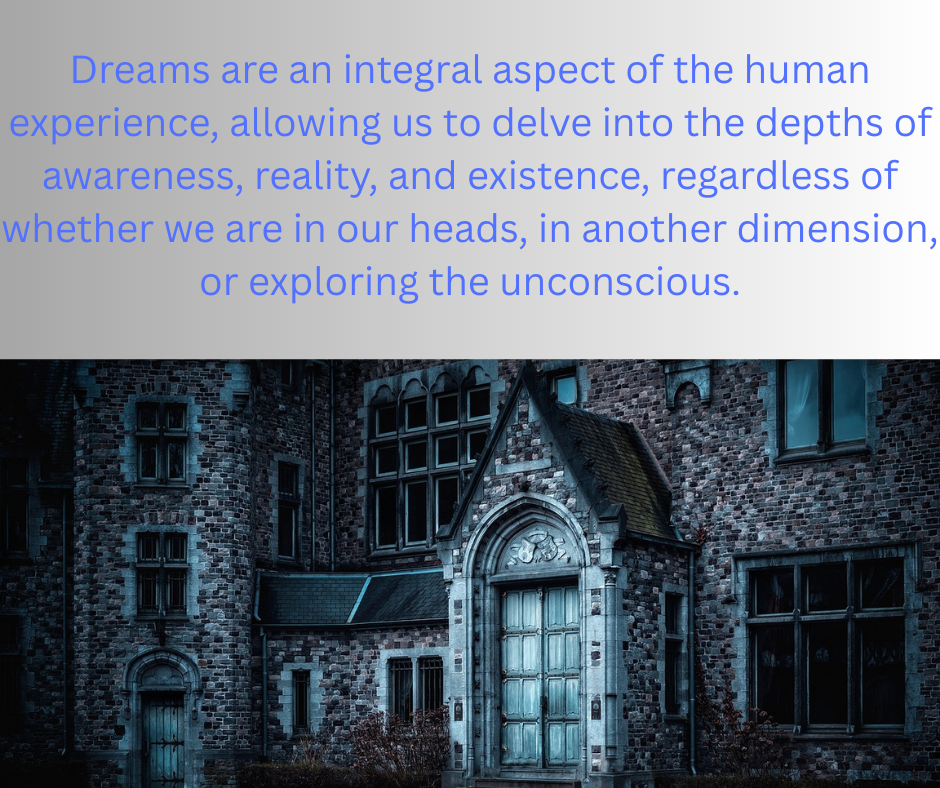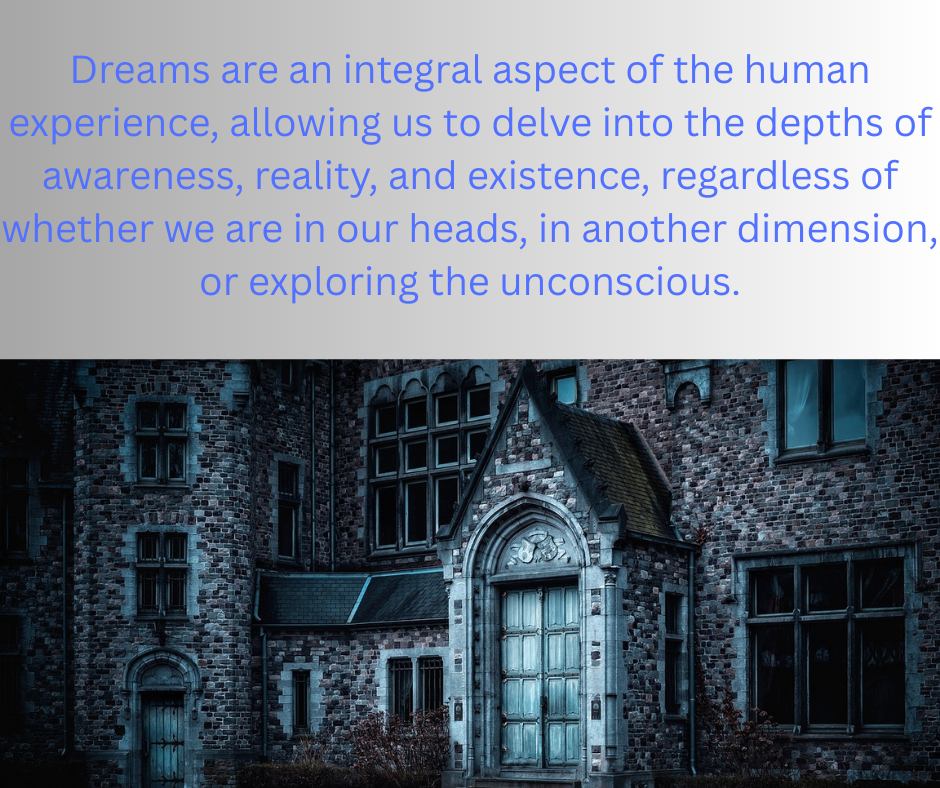For millennia, people have been fascinated and intrigued by dreams. One issue still stands, despite the fact that modern scientists are working to understand the biological and psychological implications of dreams and that ancient civilizations interpreted them as divine messages:

where are we truly when we dream? Do we feel something outside of our awake consciousness, or is our mind just working internally? Determining the nature of dreams is a difficult task that requires investigating both philosophical and scientific fields and poses profound queries regarding human awareness. The biological, psychological, and philosophical aspects of dreaming will be examined in this article along with a number of hypotheses and viewpoints regarding where we are when we dream.
Table of Contents
The Biological Perspective:
A State of Consciousness
Dreams happen while you’re asleep, especially when you’re in the Rapid Eye Movement (REM) stage of sleep, according to biology. The brain is very active during REM sleep, matching the activity of the brain during waking hours. Scientists now suggest that dreams are a way for our brain to absorb memories, feelings, and experiences while we sleep. In essence, when we dream, we are within our own minds, and the brain continues to be the major focus.
Dreams are vivid, frequently bizarre experiences that are produced by the brain’s activity during REM sleep. When it comes to place, we are inside our own minds, moving through memories, feelings, and ideas.
Areas of the brain linked to emotions, memory, and sensory processing—including the amygdala, hippocampus, and visual cortex—are particularly active during dreams in terms of neurological activity. The mind is involved in what may be described as an overactive state of imagination, even if the physical body is sound slumber. As a result, we conclude that when we dream, we are actually “inside” our own awareness and mental processes, witnessing a creation that comes from inside ourself.
Psychological Perspective:
A Reflection of the Subconscious
Many psychological thinkers contend that our subconscious thought is reflected in our dreams. The originator of psychoanalysis, Sigmund Freud, is renowned for his claim that dreams are the expression of suppressed urges and unresolved disputes. The unconscious mind can express its secret desires, fears, and thoughts that are too forbidden or undesirable for the conscious mind in the dream world, according to Freud.
Freud’s contemporary Carl Jung expanded on this theory by speculating that dreams might possibly reveal more profound aspects of the psyche. According to Jung, dreams convey signals from the “collective unconscious,” a common repository of human archetypes and experiences that cut over personal lives. According to this theory, dreams may reveal universal elements of the human condition in addition to being purely personal.
Psychological theories suggest that when we dream, we are in a much deeper mental and emotional environment than what we are aware of. Unconscious material may be the source of our dreams’ content, whether it be wants, repressed memories, or concerns. We are traversing an abstract terrain that mirrors our inner reality, which includes aspects of the past, present, and occasionally even anticipated future, rather than being in a fixed, external location.
The Philosophical Perspective:
A Realm beyond the Physical World
The question of where we are in terms of our consciousness when we dream is more metaphysical than the biological and psychological explanations. The nature of reality, consciousness, and dreams has long been a source of debate among philosophers. Some contend that dreaming casts doubt on the concept of objective reality and calls into question the essence of life itself.
The great 17th-century philosopher René Descartes is known for his skepticism on the nature of reality, which is encapsulated in the expression “Cogito, ergo sum” (I think, therefore I am). Dreams, according to Descartes, are a prime illustration of how our own minds can trick us, and he understood that our senses may trick us. Descartes argues that although dreams may seem as real as the real world, they are actually just mental constructs.
Some have developed this idea in the context of contemporary philosophy by arguing that when we dream, we are experiencing a consciousness that goes beyond the waking state rather than just being “inside” our minds.
In this way, dreams could be viewed as an investigation of several dimensions or realities. Even when we are physically asleep, the mind’s capacity for perception and creation may be guiding our consciousness as it moves through realms outside of the physical world.
Some spiritual traditions and academic debates over the nature of consciousness reflect the notion that dreaming may transport us to another dimension or reality. Some people think that dreams might provide a portal to an alternate reality where we are not limited by time or location like we are in the real world. The dream world, in some theories, is an ethereal or spiritual experience that exists apart from the physical world and is not merely a mental creation.
Lucid Dreaming:
Consciousness within the Dream
A rare condition known as lucid dreaming occurs when the dreamer realizes they are dreaming and may even have control over the dream’s plot. Because of this occurrence, people can be conscious of and interact with their dream environment while they are still asleep, obfuscating the distinction between consciousness and the dream world.
Lucid dreaming implies that we might retain some level of conscious awareness even when we are physically asleep. The idea that we are merely passive participants in our dreams is called into question by this. Rather, we might be able to control and modify our dream world, indicating that our awareness can somehow be awake and active even when we are physically asleep.

This offers an intriguing viewpoint on where we are during dreams: are we just in our imagination, or do the waking and sleeping states interact consciously
People who experience lucid dreams frequently talk about feeling more present or aware in their dreams. They may experience things more clearly and deeply than in typical dreams during these times, giving them the impression that they are in a completely new planet or realm. The idea that we might be in a place that extends beyond the confines of our physical surroundings and even our conscious awareness is made possible by lucid dreaming.
The Nature of Time and Space in Dreams
The apparent differences in how time and space operate in dreams is another intriguing feature. In many dreams, complete events unfold in what seem like moments, and time seems to move at a different pace than it does in real life. We may seem to go through years of existence in a few minutes within a single dream. This warps our sense of “where” we are in relation to temporal reality and physical space.
In our dreams, we frequently encounter bizarre situations in which we can be in one location one minute and somewhere else the next, with no discernible change in location. This implies that the dream world is not subject to the usual limitations of physical space. Therefore, “where” we are in a dream may describe a psychological or emotional state rather than a precise location, frequently impacted by memories, emotions, or unresolved issues from our waking lives.
The notion that our minds are not limited by time or space as we perceive them in the real world is hinted at by this experience. Rather, we might reach a point where these physical rules are no longer relevant. In this way, dreams could not even have a specific “location,” but rather take place in a space that is wholly influenced by our awareness.
Cultural and Spiritual Perspectives on Dream Locations
Dreams are frequently seen as a link to the spiritual world, the divine, or otherworldly experiences in a variety of cultures and spiritual traditions. For example, in indigenous cultures, dreams may be interpreted as a chance to communicate with ancestors, learn insight, or visit the spirit world.
Dreams are also seen as sacred experiences that link the dreamer to a transcendent level of awareness or a higher power in many religious systems.
In these situations, we can dream that we are traveling into an other spiritual realm or dimension and leaving our physical body behind. Dreams are interpreted in certain cultures as messages from ancestors, the gods, or other supernatural entities. This implies that the “location” of dreams in these cultural contexts is a spiritual or metaphysical space that exists outside of physical reality rather than only within the mind or body.
Conclusion:
Where we are when we dream is an issue that crosses several academic fields, including philosophy, psychology, biology, and even theology. We are obviously in our own minds, experiencing a very active state of awareness, according to science. In terms of psychology, we might be resolving problems, facing emotions, and navigating the subconscious.
Dreams may transport us to different worlds or dimensions where we are able to transcend the confines of the material world, both philosophically and spiritually.
